|
|
MXene: Coming up Roses
HUANG Qing
2024 Vol. 39 (2): 113–114
 Abstract
Abstract(
342 )
 HTML
HTML(
17)
 PDF
PDF(233KB)(
358
)
MXene material has gained popularity among scientists since its discovery in 2011. It has shown great potential in various fields such as energy storage, catalysis, environment, wave absorption, biotherapy, and high-performance composite materials. A series of special perspectives have been organized to provide an overview of the latest research progress and challenges in MXene material science. The invited experts have shared their research highlights and discussed existing problems and future directions. Synthesis is the foundation of MXene research, with nearly all studies employing chemical methods that use fluoride etchants to transform MAX phases into MXenes. Strategies like Lewis acid molten salt etching and “chemical scissors” for structural editing offer new perspectives for customized synthesis. MXene possesses key physicochemical properties crucial for electronic applications, significantly impacting the study of electronic devices. MXene materials have broad application prospects in flexible photodetectors, solar cells, electronic devices, and energy applications. Moreover, MXene’s metallic conductivity and accordion-like structure make it useful for pressure sensors and electromagnetic shielding. MXene is also a hot topic in the field of energy storage, such as the latest developments in anodes, cathodes, and electrolytes/separators for zinc-ion batteries. Journal of Inorganic Materials expresses gratitude to the invited experts and reviewers for their contributions and looks forward to more updates on MXene research findings. In summary, MXene materials have shown great potential due to their unique properties and have made significant breakthroughs in various fields. However, there are still many challenges to be addressed, such as the environmental stability and packaging technology of MXene materials. With continuous efforts from researchers, it is expected that more exciting findings and breakthroughs will be achieved in the future.

|
|
|
Chemical Scissor-mediated Structural Editing of Inorganic Materials
DING Haoming, CHEN Ke, LI Mian, LI Youbing, CHAI Zhifang, HUANG Qing
2024 Vol. 39 (2): 115–128
 Abstract
Abstract(
545 )
 HTML
HTML(
25)
 PDF
PDF(5860KB)(
267
)
Inspired by gene scissor concept in biological genetic engineering, chemical scissors, as important research tools, play an important role in the study of structure editing and application of materials. We aim to review the research progress of chemical scissors in structural editing and applications of materials. First of all, we introduce the basic concept and mechanism. Chemical scissors strategy refers to a methodology for material editing through which the main crystal structure is preserved but targeted atoms or structural units are knocked out, replaced, repaired or reconstructed in order to realize special functionality. Subsequently, the specific applications of chemical scissors in materials structure editing are discussed in depth, including the methods and functional designs for precise structure modulation of materials by chemical shearing, modification, synthesis, as well as etching and intercalation. Finally, the future research direction of chemical scissors in the field of material structure editing is envisioned, including developing new chemical scissors that are more intelligent and efficient, exploring more innovative strategies for material structure editing, understanding the underlying chemical mechanism, and further expanding the applicability of chemical scissors. Overall, we summarize the research progress and potential of material structural editing, which provides important theoretical and experimental support for further exploring and developing the application of chemical scissors in the field of materials.
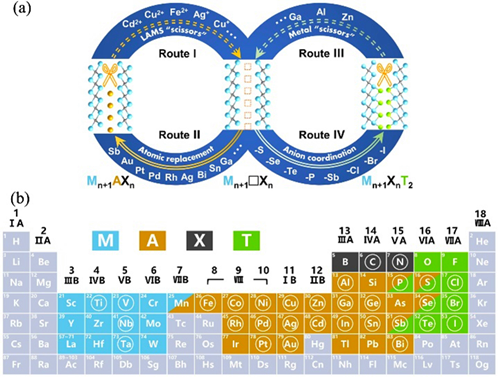
|
|
|
Terahertz Electromagnetic Shielding and Absorbing of MXenes and Their Composites
WAN Hujie, XIAO Xu
2024 Vol. 39 (2): 129–144
 Abstract
Abstract(
552 )
 HTML
HTML(
26)
 PDF
PDF(13355KB)(
493
)
Developing novel low-dimensional materials for terahertz electromagnetic shielding and absorbing applications represents a critical research frontier. Their unique electrical, mechanical, and electromagnetic responses hold great potential in enabling more efficient solutions for electromagnetic shielding and absorbing. Two-dimensional transition metal carbides, nitrides, and carbonitride MXenes have already demonstrated excellent electromagnetic shielding and absorbing performance in the low-frequency spectrum. MXenes possess high conductivity, low density, and high flexibility, which are advantageous for future portability and integration of terahertz devices and systems. However, practical implementation of MXene-based terahertz electromagnetic shielding and absorption materials faces challenges in adhesion stability, environmental resilience, and high-temperature tolerance, hindering their suitability for aerospace and future next generation communication applications. Moreover, in terahertz frequency band, lacking more comprehensive and reliable electromagnetic scattering and absorbing measurement methods limits the development of THz shielding and absorbing materials. Extensive research efforts have targeted on these limitations, exploring fundamental architectural and theoretical aspects of prevalent electromagnetic materials. This review specifically highlights the terahertz electromagnetic shielding and absorption characteristics inherent in various MXenes and their compositions, such as Ti3C2Tx, Mo2Ti2C3Tx, Mo2TiC2Tx, Nb4C3Tx, and Nb2CTx. Additionally, this review envisages the forthcoming challenges and prospects of MXenes as a pivotal electromagnetic shielding and absorbing material within the terahertz frequency band.
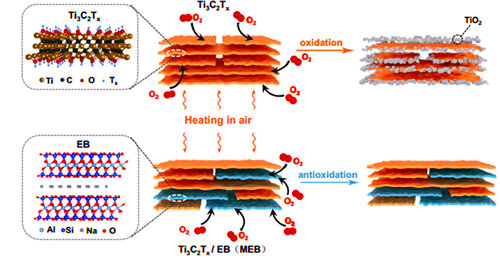
|
|
|
Metal Matrix Composites Reinforced by MAX Phase Ceramics: Fabrication, Properties and Bioinspired Designs
LIU Yanyan, XIE Xi, LIU Zengqian, ZHANG Zhefeng
2024 Vol. 39 (2): 145–152
 Abstract
Abstract(
439 )
 HTML
HTML(
13)
 PDF
PDF(17046KB)(
462
)
MAX phase ceramics, with their mixed covalent-metallic-ionic atomic bonds, can uniquely combine the advantages of both metals and ceramics, offering a series of distinctive characteristics. The particular layered atomic structure further endows them with decent fracture toughness, good damping capacity, and self-lubricating property. As such, MAX phase ceramics are more appealing to serve as reinforcements for metal matrix composites (MMCs) than conventional ceramic materials. Here, we foused on the development. To date, fabrication of MMCs reinforced by MAX phase ceramics still involves the use of stir casting, powder metallurgy, and melt infiltration techniques. The obtained composites made by different methods may display distinct differences in their structural characteristics, show notable enhancement in strength, hardness, and stiffness as compared to their metal matrices, and exhibit good wear resistance, high electrical conductivity and remarkable arc erosion resistance. Moreover, ultrafine MAX phase platelets can be preferentially oriented and aligned, e.g., by using vacuum filtration or ice templating techniques. By infiltrating metal melt into partially sintered porous ceramic scaffolds, bioinspired composites with nacre-like architectures can be obtained, thereby affording further improvement in strength and fracture toughness. Sufficient combinations of mechanical and functional properties enable the MMCs reinforced by MAX phase ceramics promising for a variety of applications, such as load-bearing structures, electrical contact materials. These composites can offer enhanced strength, stiffness, and wear resistance, making them ideal candidates for these applications.
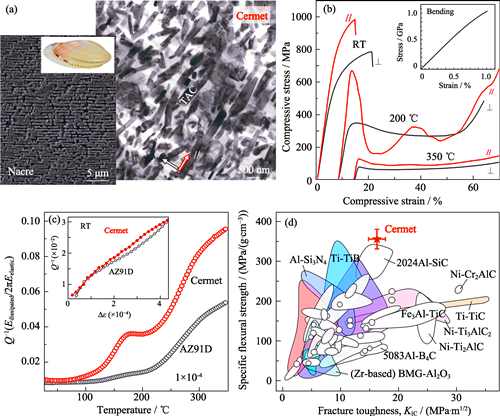
|
|
|
Recent Advances in the High Performance MXenes Nanocomposites
LI Lei, CHENG Qunfeng
2024 Vol. 39 (2): 153–161
 Abstract
Abstract(
593 )
 HTML
HTML(
16)
 PDF
PDF(8840KB)(
636
)
Two-dimensional transition metal carbon/nitride MXenes show promising applications in various fields due to their remarkable electrical and mechanical properties. Recently, the research of high performance MXenes nanocomposites (including one-dimensional fibers, two-dimensional films and three-dimensional blocks) has made remarkable progress. However, the mechanical properties are still far lower than the intrinsic mechanical properties of MXenes nanosheets, mainly due to the key scientific problems of voids, misalignment of MXenes nanosheets and weak interfaces. In order to solve the above problems, the intrinsic mechanical properties of MXenes nanosheets are firstly discussed in this work, then the development of high performance MXenes nanocomposites are summarized, and the latest research progress of high performance MXenes nanocomposites is discussed in detail, including how to eliminate void, improve the orientation of MXene nanosheets and enhance the interface interaction. Meanwhile, the applications of high performance MXenes nanocomposites in the fields of electric heating, thermal camouflage, electromagnetic shielding, sensing and energy storage are introduced. Finally, the challenges and future development directions of high performance MXenes nanocomposites are proposed.
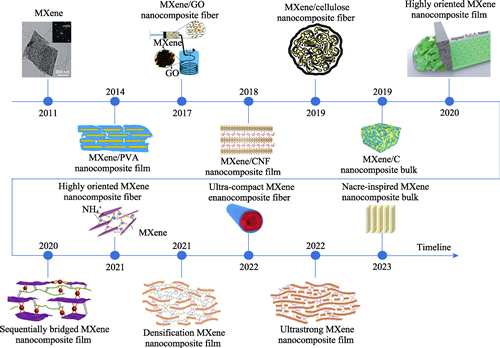
|
|
|
Perspectives for Infrared Properties and Applications of MXene
BA Kun, WANG Jianlu, HAN Meikang
2024 Vol. 39 (2): 162–170
 Abstract
Abstract(
600 )
 HTML
HTML(
17)
 PDF
PDF(14746KB)(
578
)
MXene is a large family of two-dimensional transition metal carbides, nitrides or carbonitrides. Its characteristics (various compositions, two-dimensional atomic layer structures, metallic electrical conduction, active surfaces, etc.) render MXene unique interactions with electromagnetic waves at different frequencies (visible light, infrared, terahertz, microwave, etc.), deriving a variety of electromagnetic functional applications. In the infrared range, MXene has a wide range of infrared radiation properties, and its active surface endows tunable infrared absorption. These features have attracted researchers’ interest in exploring infrared properties of MXene and the corresponding applications in recent years. In this perspective, the intrinsic infrared characteristics and manipulation strategies of different MXenes are systematically summarized, and the research progress of representative infrared applications are briefly introduced, including infrared identification/camouflage, surface plasmon, photothermal conversion, and infrared photodetection. Particularly, the contribution and mechanism of MXene in these applications are discussed. Finally, the outlook for infrared functional applications with MXenes is proposed.
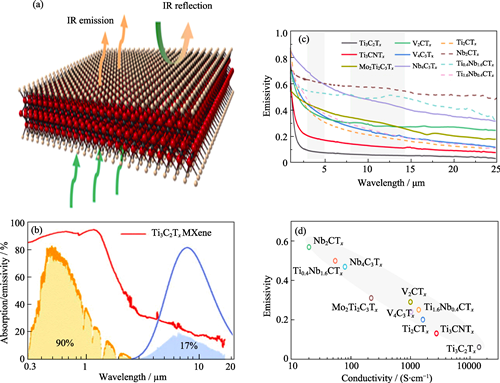
|
|
|
Perspective of MXetronics
XU Xiangming, Husam N ALSHAREEF
2024 Vol. 39 (2): 171–178
 Abstract
Abstract(
354 )
 HTML
HTML(
11)
 PDF
PDF(8300KB)(
307
)
Atomic-thin transition metal carbonitrides (MXenes), as an emerging class of two-dimensional (2D) materials, become a highly active research topic. Since the discovery of graphene nearly 20 years ago, many 2D materials (graphene, transition metal dichalcogenides, and black phosphorus) have been extensively studied in the field of micro-nano electronics. However, research on MXenes-based micro-nano electronics has just begun. MXenes exhibit rich elemental compositions and unique physicochemical properties, such as hydrophilicity, tunable work function, adjustable functional groups, fast ion and electron transport, superconductivity, surface plasmons, photo- thermo-electricity, and electromagnetic absorption, and some MXenes even possess high conductivity. These characteristics make MXenes hold great potential for device applications at the microscale or even nanoscale. In recent years, the Alshareef research group has been dedicated to bringing MXenes into the field of micro-nano electronics and has defined the emerging academic field of MXene electronics, known as MXetronics, in 2019. This perspective briefly summarizes and evaluates representative research progress in this field, including the challenges in synthesis, processing, property investigation, and device applications at the microelectronic level. Furthermore, we will propose several key research directions and unexplored subfields in this area.
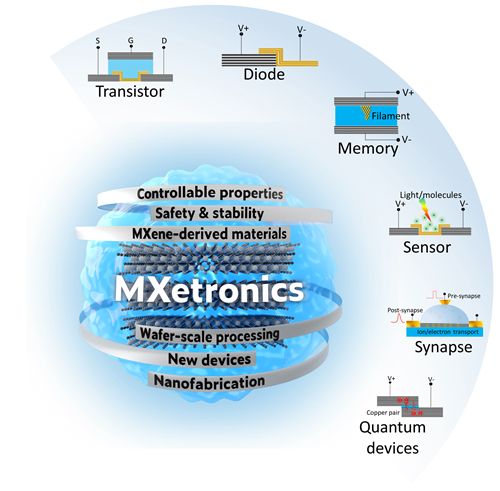
|
|
|
Recent Progress of MXene in Pressure Sensing
YIN Jianyu, LIU Nishuang, GAO Yihua
2024 Vol. 39 (2): 179–185
 Abstract
Abstract(
299 )
 HTML
HTML(
12)
 PDF
PDF(2094KB)(
352
)
In recent years, pressure sensors have been widely applied in the fields of smart wearable textile, health detection, and electronic skin. The emergence of the two-dimensional nanomaterial MXene has brought a brand-new breakthrough for pressure sensing. Ti3C2Tx is the most popular studied MXene in the field of pressure sensing and shows good mechanical, electrical properties, excellent hydrophilicity, and extensive modifiability, enabling it an ideal material for pressure sensing. Hence, researchers have conducted a lot of explorations and studies on design and application of MXene in pressure sensors in recent years. Herein, the preparation technologies and antioxidant methods are summarized. Design of MXene-based microstructures is also introduced, including aerogels/porous structural materials, hydrogels, flexible substrates, and films, which are beneficial to improve the response range, sensitivity, and flexibility of pressure sensors, and promote the rapid development of pressure sensors. The mechanisms of MXene pressure sensors are further broached, including piezoresistive, capacitive, piezoelectric, triboelectric, battery typed and nanofluidic. MXene has been applied in a wide range of sensors for various mechanisms due to its excellent characteristics. Finally, the chance and challenge in the synthesis, properties, and pressure sensing performance of MXene materials are prospected.
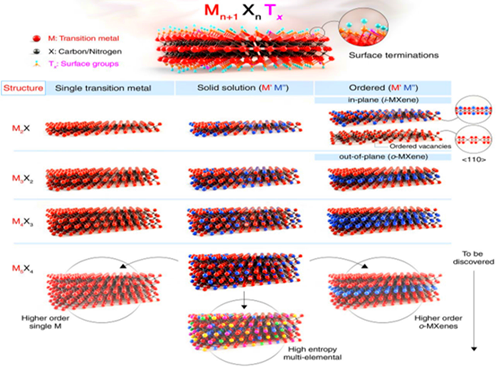
|
|
|
2D MXenes Based Flexible Photodetectors: Progress and Prospects
LI La, SHEN Guozhen
2024 Vol. 39 (2): 186–194
 Abstract
Abstract(
376 )
 HTML
HTML(
15)
 PDF
PDF(7535KB)(
387
)
Two-dimensional (2D) transition metal carbides/nitrides (MXenes), since their discovery in 2011, have attracted great attention in the fields of energy storage, catalysis, sensors, electromagnetic interference shielding and microwave absorption and so on, owing to their special 2D layered structure, excellent electrical conductivity and electrochemical properties. In recent years, with the deep understanding of MXenes, the research on the realm related to optoelectronic properties has been widely concerned. Unlike other application fields, optoelectronic devices based on MXenes focus on extending semiconductor properties, including tunable band gap of the MXenes via design of the surface functional groups and layer control, etc., so as to achieve their transformation from metal to semiconductor properties. This paper revolves around the photoelectric properties of MXenes, mainly introduce its application in flexible optoelectronic devices, and systematically describe their current status and trend in transparent electronic devices, photodetectors, image sensors, transistors, and artificial neural vision network systems. The challenges and future development prospects of MXenes-based flexible optoelectronic devices are also proposed.
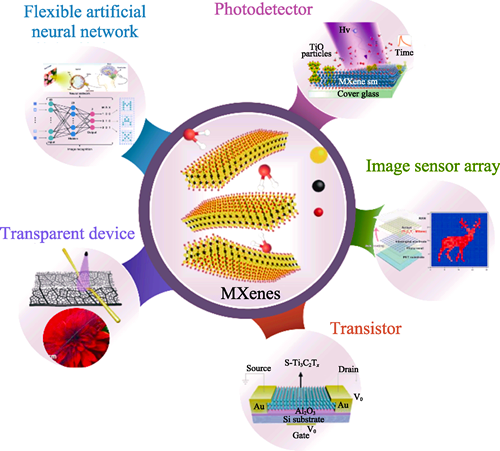
|
|
|
MXene Multifunctional Inks: a New Perspective toward Printable Energy-related Electronic Devices
DENG Shungui, ZHANG Chuanfang
2024 Vol. 39 (2): 195–203
 Abstract
Abstract(
407 )
 HTML
HTML(
9)
 PDF
PDF(5403KB)(
381
)
Advanced ink printing techniques, such as printing and coating, have overcome the limitations of traditional manufacturing methods, allowing for rapid prototyping of films and electronic devices with sophisticated structures and specific functions. These techniques hold enormous potential in wearable smart identification, energy storage, electromagnetic shielding and absorption, touch display, and so on. The key to printing advanced energy and electronic devices lies in the development of cutting-edge functional inks and their corresponding printing technologies. MXene, a family of two-dimensional compounds composed of transition metal carbides, nitrides, or carbonitrides, was discovered in 2011. MXene exhibits remarkable physical and chemical properties, including high conductivity, pronounced hydrophilicity, and diverse surface chemistry, which has garnered significant attention within the research community and made it particularly suitable as inks in printing applications. Conducting research on the printing behavior and mechanisms of MXene inks is crucial not only for achieving high-precision patterns but also for establishing a solid foundation for manufacturing techniques that can precisely create multiscale, multimaterial and multifunctional films, and electronic devices. This article begins with a brief discussion of MXene flakes’ synthesis and colloidal stability, followed by a detailed examination of its rheological characteristics, printable ink formulation, and printing methods. Additional, special attention is given to the latest advances of MXene ink in energy, health, and sensing applications. The perspective concludes with a summary of current research challenges and future directions in this area, offering new perspectives and insights for researchers.
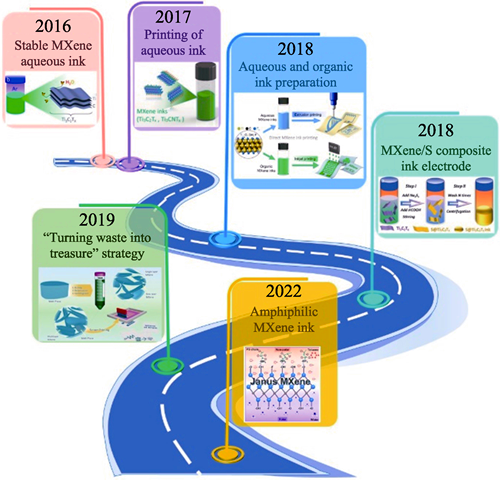
|
|
|
MXene Based Zinc Ion Batteries: Recent Development and Prospects
CHEN Ze, ZHI Chunyi
2024 Vol. 39 (2): 204–214
 Abstract
Abstract(
307 )
 HTML
HTML(
20)
 PDF
PDF(7499KB)(
237
)
Rechargeable zinc-ion batteries (ZIBs) have captured significant attention as promising solutions for large-scale energy storage. They offer advantages such as low cost, inherent safety, high specific energy, and eco-friendliness. Though numerous breakthroughs have been achieved in the development of cathodes, anodes and electrolytes, ZIBs are still far behind for practical application due to the lack of advanced materials. In the realm of ZIBs, two-dimensional (2D) MXenes have emerged as a fascinating candidate, leveraging their exceptional properties such as high richness, customizability, and unique physiochemical attributes. This review aims to provide a concise overview of advancements in MXene application for ZIBs, encompassing multiple synthesis routes, properties, morphological and structural characteristics, as well as various chemistries employed. Furthermore, detailed elucidation is provided on the recent progress in MXene-based cathodes, anodes, and electrolytes/separators for ZIBs, indicating the great potential of MXenes for achieving high-performance ZIBs. Strategies to enhance the performance of MXene-based ZIBs are also highlighted, including ion-intercalation adjustment, surface modification, heteroatoms doping, and layer spacing widening. Lastly, the review discusses the current challenges and future prospects for MXene-based ZIBs, paving the way for further research and development in this exciting field.
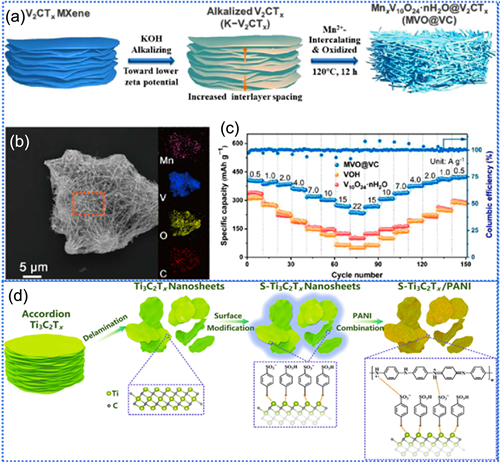
|
|
|
Progress of Two-dimensional MXene in New-type Thin-film Solar Cells
FEI Ling, LEI Lei, WANG Degao
2024 Vol. 39 (2): 215–224
 Abstract
Abstract(
235 )
 HTML
HTML(
17)
 PDF
PDF(5843KB)(
426
)
As renewable and sustainable clean energy, solar energy has the potential to address current energy shortage and reduce environmental pollution caused by fossil fuels consumption. In recent years, the third-generation thin-film solar cells, such as dye-sensitized solar cells (DSSCs) and perovskite solar cells (PSCs), have attracted widespread attention due to their low cost, abundant materials, and high photoelectric performance. However, these devices still face challenges in terms of charge transfer efficiency and operational stability for their commercialization. Two-dimensional (2D) MXene materials have emerged as promising candidates for improving the performance of thin-film solar cells due to their unique properties, including high specific surface area, rich surface functional groups, high conductivity, tunable work function, and hydrophilicity. This review summarizes the recent research progress of 2D MXene materials applied in new thin-film solar cells, focusing on the reaction mechanism that enhances the photoelectric performance of solar cells. Strategies such as using 2D MXene materials as additives for the perovskite layer and charge transport layer in PSCs, modifying the photoanode in DSSCs, and preparing varous electrodes, can effectively improve light absorption efficiency, carrier mobility, and charge extraction capability of the devices by adjusting band alignment, reducing work function, broadening the light absorption range, and creating a “pillar support effect”. As a result, the photoelectric performance and stability of the devices are enhanced. In conclusion, the perspectives highlights the current research progress and challenge faced by 2D MXene materials in novel thin-film solar cells.
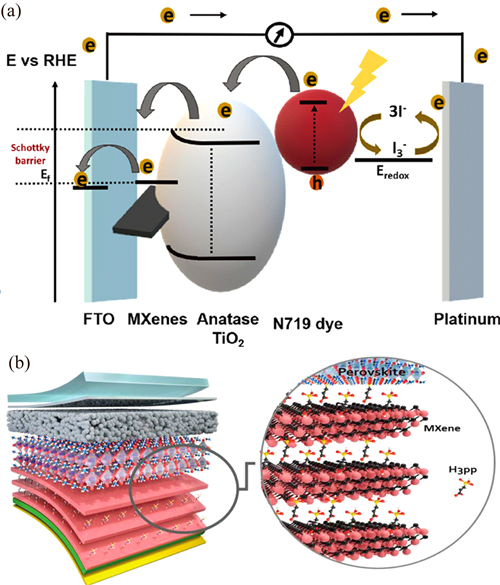
|
|
|
Predictions of Phase Stability and Properties of S-group Elements Containing MAX Borides
ZHANG Yuchen, LU Zhiyao, HE Xiaodong, SONG Guangping, ZHU Chuncheng, ZHENG Yongting, BAI Yuelei
2024 Vol. 39 (2): 225–232
 Abstract
Abstract(
219 )
 HTML
HTML(
13)
 PDF
PDF(1047KB)(
250
)
Zr2SB, Hf2SB, Zr2SeB, Hf2SeB, and Hf2TeB are all recently discovered S-group elements containing MAX-phase borides, which attract much attention since the MAX phase borides are significantly unlike the typical MAX phases. Here, the phase stability, mechanical properties and thermal properties of MAX phase borides (M = Zr, Hf, A = S, Se, Te) were studied by using first principles and "linear optimization method", bond stiffness model and quasi-simple harmonic approximation. The results of the theoretical analysis were consistent with the currently available experimental results. Only M2AB was found to be stable after thermodynamic and intrinsic stability analysis. The shorter M−A bond and M−B bond lengths cause bond stiffness of Hf lineage higher than that of Zr, which also leads to the higher hardness of Hf lineage compound than that of Zr. the A site element goes from S to Se and to Te, the bond lengths of M−B and M−A are gradually increased, which lead to decrease in the elastic modulus. Moreover, the bulk modulus of these compounds is determined by their average chemical bond stiffness. Importantly, the high kmin/kmax (stiffness ratio of the weakest and the strongest bonds) shows that these MAX phases are inherently brittle, different from conventional MAX phase. Including the contribution of lattice vibration (phonon) and electron excitation, the isobaric heat capacity and heat expansion coefficient of M2AB increase rapidly with increasing the temperature below 300 K and then the rise rate gradually decreases, similar to other MAX phases. Lower bond stiffness results in an overall higher TEC of MAX phase borides in the Zr lineage than in the Hf lineage. The TEC values of these compounds in the 300−1300 K interval are consistent with most of the MAX and MAB phases.

|
|